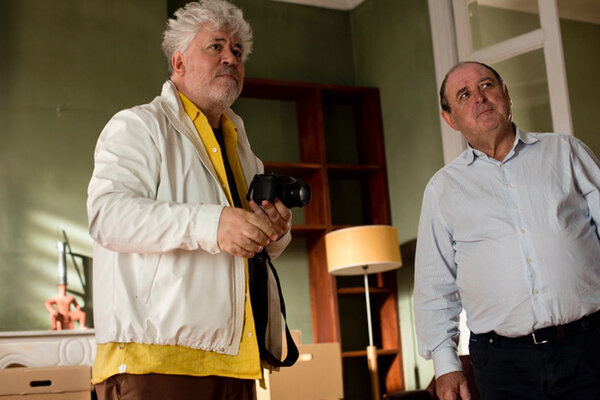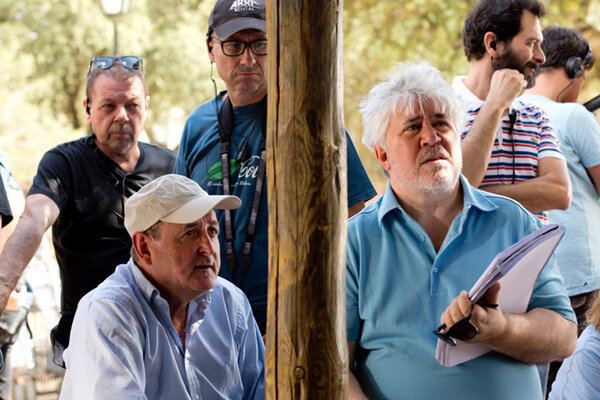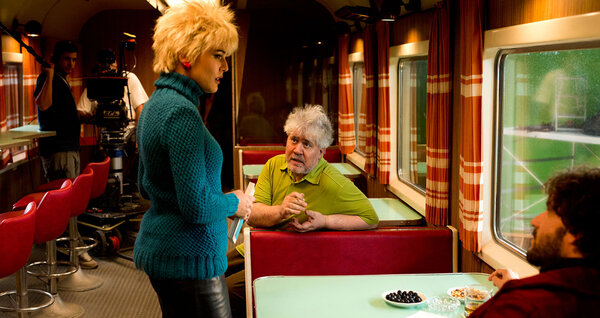Julieta

As soon as we met, I began to ask myself very basic questions. How could I find my place faced with the strong personality of this true “Man of La Mancha” ? How could I become part of his personal mythology, and from there, invent the lighting for his twentieth feature-length film ?
During shooting, I didn’t leave his side for a second, in order to remain attentive to the artist that he is above all, to the liveliness of his language, to his perspective on the world, to his discussions with the actors. A thousand times, I laughed as I watched him exist like that.
It was the accumulation of successive intuitions, day after day, that allowed me to find a way to advance. He is constantly inventing and calling people out as he builds his mountain, with a strength of character and a certain nostalgia, but everything is covered over with a great deal of humour.
In order to prepare, I made a number of trips to Madrid, Andalusia, Galicia, and Aragon. I put together a team of collaborators who turned out to be remarkable : Fernando Beltran, the gaffer, Carlos Miguel, the key grip, José Ramon Delgado, the focus-puller, and Joaquín Manchado, the camera operator. His presence turned out to be essential because of his great skill, his humanity, and how well he knew Pedro.

In parallel, I decided on the type of equipment we’d be using, prepared strategies, especially for the first two weeks of shooting at night, in the train, in the Algodor train station, which had been entirely remodelled for the film, as well as for the floors of the building where Julieta lived two separate lives, in order to recreate different time periods and make sure the sun would be able to flood the sets from time to time.
I had the same approach to the inside of Yoan’s house in Galicia, which was reconstructed in studio.
Suddenly, the screen-tests began with two full weeks of shooting, with the actors and the full team. It was an impressionistic approach, an often radical one, in order to arrive at the final general visual style, the sets, and the actors’ appearances. This is the case for all films, but with Pedro, the anarchy takes on epic proportions : it’s a bit like trying to pick up the pieces of a game that have been scattered on the floor.
Every morning, with Chema Alba, the colourist, we worked closely together to colour time the images we’d filmed the previous day on a big screen in the Deluxe laboratory for two hours. At noon, we’d watch them with Pedro.
Sometimes, it went well ; other times, it was horrible. We’d have to shoot everything over again over a minor detail. And another day began.
These experiences were very instructive. They allowed us to understand what our margins of manoeuvre were, because Pedro never says whether he likes a scene, nor how it could be changed in order to suit him…
And then, one day, we were able to begin shooting Julieta.

The references that were most important for me were his films, his great ability to create outside of technical conventions.
The discovery of his notebooks, also, which were full of images, impressions of lighting, colours, materials, hairstyles, makeup styles. Basically, all of the objects within his personal Pantheon, all of the feelings that strongly gripped him and guide him in his approach to his characters.
He chooses the colour of each set with an incommensurable ardour and acuity. He might change from one day to the next, but never strays far from his centre.
I followed my path as though I were putting together, in procession, a royal bouquet of flowers. I penetrated into Pedro’s intense and colourful world with curiosity and emotion. He is accompanied within El Deseo by his brother Augustin, and Esther García, who is its soul and compass.
I wanted to design the lighting as though I were staging an opera, with contours, character, climates, respect for the beauty of the faces and the characters’ flamboyant gazes.
The scene in the train, despite its apparent simplicity, is in reality composed of a superposition of various techniques that were brought out in digital editing by El Ranchito, under the wise guidance and Olympian calm of Edu Dias.
The train was travelling on a winter’s night. Then the train arrives in a station and begins to leave, but brakes abruptly.
When the train finally starts off again, we’re in a studio filming the scenes inside the compartments.
I colour timed the film at Deluxe Laboratories, in collaboration with Chema.
During the week, Pedro would come and tell us what he thought about our work, and was exceptionally sensitive to the slightest change in colour or saturation.
And in the end, we overcame all obstacles !
For me, working on this film was an unforgettable human and technical experience.
(Translated from French by Alexander Baron-Raiffe)
Équipe
Team :Operator : Joaquín Manchado
Focus Puller : José Ramón Delgado
DIT : Montsé Motril
Gaffer : Fernando Beltran
Key Grip : Carlos Miguel
Technique
Technical Information :Camera : Arri Alexa XT Plus RAW, 1.85 format
Lenses : Cooke Series S4 set (32, 40, 50, 65, 75, 100, 135, 180, 300mm), Angénieux Optimo 28-76mm T2.6 zoom
DIT Station, live grade, patch panel, 1 Aia
 En
En Fr
Fr








